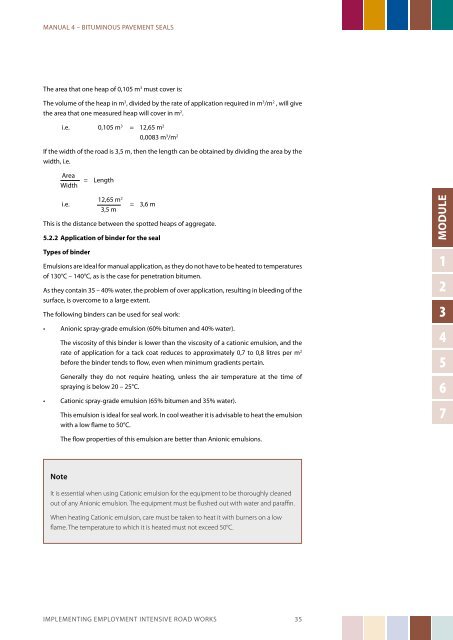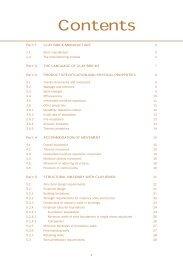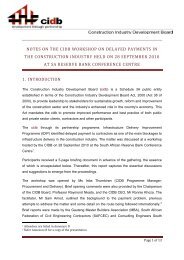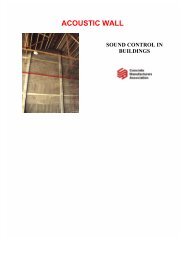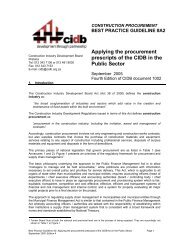MANUAL 4 - Construction Industry Development Board
MANUAL 4 - Construction Industry Development Board
MANUAL 4 - Construction Industry Development Board
Create successful ePaper yourself
Turn your PDF publications into a flip-book with our unique Google optimized e-Paper software.
<strong>MANUAL</strong> 4 – BITUMINOUS PAVEMENT SEALS<br />
The area that one heap of 0,105 m 3 must cover is:<br />
The volume of the heap in m3 , divided by the rate of application required in m3 /m2 , will give<br />
the area that one measured heap will cover in m2 .<br />
i.e. 0,105 m 3 = 12,65 m 2<br />
0,0083 m 3 /m 2<br />
If the width of the road is 3,5 m, then the length can be obtained by dividing the area by the<br />
width, i.e.<br />
Area = Length<br />
Width<br />
i.e.<br />
12,65 m2 = 3,6 m<br />
3,5 m<br />
This is the distance between the spotted heaps of aggregate.<br />
5.2.2 Application of binder for the seal<br />
Types of binder<br />
Emulsions are ideal for manual application, as they do not have to be heated to temperatures<br />
of 130°C – 140°C, as is the case for penetration bitumen.<br />
As they contain 35 – 40% water, the problem of over application, resulting in bleeding of the<br />
surface, is overcome to a large extent.<br />
The following binders can be used for seal work:<br />
• Anionic spray-grade emulsion (60% bitumen and 40% water).<br />
The viscosity of this binder is lower than the viscosity of a cationic emulsion, and the<br />
rate of application for a tack coat reduces to approximately 0,7 to 0,8 litres per m 2<br />
before the binder tends to flow, even when minimum gradients pertain.<br />
Generally they do not require heating, unless the air temperature at the time of<br />
spraying is below 20 – 25°C.<br />
• Cationic spray-grade emulsion (65% bitumen and 35% water).<br />
This emulsion is ideal for seal work. In cool weather it is advisable to heat the emulsion<br />
with a low flame to 50°C.<br />
Note<br />
The flow properties of this emulsion are better than Anionic emulsions.<br />
It is essential when using Cationic emulsion for the equipment to be thoroughly cleaned<br />
out of any Anionic emulsion. The equipment must be flushed out with water and paraffin.<br />
When heating Cationic emulsion, care must be taken to heat it with burners on a low<br />
flame. The temperature to which it is heated must not exceed 50°C.<br />
IMPLEMENTING EMPLOYMENT INTENSIVE ROAD WORKS 35<br />
MODULE<br />
1<br />
2<br />
3<br />
4<br />
5<br />
6<br />
7


